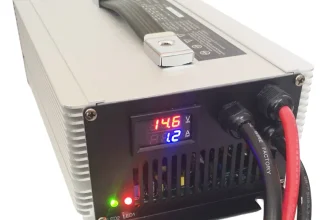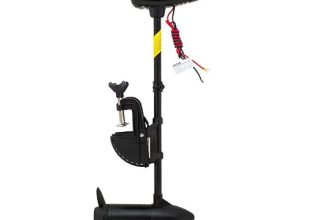Trolling motor batteries are types of batteries that are specifically developed for use with a boat trolling motor.
They are designed to give electricity over a longer length of time when leisurely trolling through fishing locations.
Trolling motor batteries differ from marine starting batteries in that marine batteries are only used to crank a motor, while trolling motor batteries constantly provide power to run the electric trolling motor.
If you are in the market for a new trolling motor battery or would just like to learn more about these special marine batteries, continue reading on.
Check Trolling Motor Battery Prices
What is a Trolling Motor?
This page’s primary goal is to give information about trolling motor batteries, but let’s spend a little time talking about what a trolling motor is.
A trolling motor is a small electric motor on a boat that allows the boat to move through the water at low speed making minimal noise.
This is great when you are fishing since a lot of noise or disturbance in the water will likely scare fish away.
What are Trolling Motor Batteries?
For a boat or other watercraft with a gasoline engine to start and run, they must be equipped with a battery to start the engine, just like a regular car or truck.
These types of batteries are usually designed to provide a lot of power in short bursts that starting an engine of this type requires.
One the engine is started they are charged back to full capacity by a charging system powered by the boat’s main engine.
Trolling motors use a type of battery called deep-cycle batteries.
Deep cycle batteries are designed to provide a low to moderate amount of current over a long period of time rather than a very high amount of current over a small amount of time.
This is exactly what a trolling motor needs to operate.
Check Trolling Motor Battery Prices
Types of Trolling Motor Batteries
There are currently three main types of deep cycle batteries on the market that are recommended for use in trolling motors.
These types of batteries are lead acid flooded cell, AGM, and lithium ion.
Each type of these batteries has both pros and cons.
Let’s compare all three trolling motor battery types to help you determine which battery is right for you.
Lead Acid Flooded Cell Trolling Motor Battery
The most typical deep cycle batteries for trolling boat motors are lead acid flooded cell batteries.
They are the cheapest alternative and can withstand the repeated draining and recharging required with trolling motor use.
Lead acid batteries have a lifespan of around 5 years give or take, depending on quality, how well they are maintained, and how much they are used.
These types of trolling motor batteries generally cost between $75 and $200 and are widely available in many retail shops as well of online.
The drawback of some lead acid flooded cell batteries is that they can require occasional servicing – topping off the water – and they are also particularly susceptible to vibration and spillage.
Many modern lead acid flooded cell batteries are sealed and do not require checking and adding water.
These sealed lead acid batteries also eliminate the issue of battery acid spilling from the battery.
Typical lead acid trolling motor batteries on average will last around 8 hours on a single charge before needed another 8 full hours to recharge.
These types of trolling motor batteries usually weigh between 40 – 80 pounds, depending on their capacity.
Pros and Cons of a Flooded Cell Lead Acid Battery
If you are considering a lead acid flooded cell battery for your trolling motor, there are a few pros and cons that you should weigh before buying something.
Some advantages of lead acid batteries are that they are cheap, widely available, and require little maintenance.
On the downside, these batteries are heavy and need to be recharged frequently, therefore limiting your trolling motor run time.
Check Trolling Motor Battery Prices
Absorbed Glass Mat (AGM) Trolling Motor Battery
Absorbed Glass Mat, or AGM Batteries, are a form of lead acid battery that is entirely sealed, lasts longer on a charge, and has a longer lifespan.
A typical deep cycle battery may last around 5 years, however an AGM deep cycle battery may last up to 10 years.
AGM batteries cost more than normal lead acid flooded cell batteries and may not be an option for individuals on a restricted budget.
They are more expensive, but they have a longer lifespan and perform better on the water.
AGMs also offer the advantage of being completely maintenance free.
Pros and Cons of AGM Battery
As with the lead acid trolling motor battery, the AGM battery has both advantages and disadvantages that you should consider before deciding on a battery that is right for you.
AGM batteries are the same size and weight of normal flooded cell lead acid batteries.
The main difference of AGM batteries is that the liquid acid inside an AGM battery is suspended in glass mats between the battery plates.
They are safer to handle and have special valves to limit the amount of gasses that escape during charging, this helps improve battery life.
With no maintenance and a good warranty, it is easy to see why many people choose the AGM battery.
AGM batteries are more durable, but the biggest drawback to AGM batteries is the cost.
If you are looking to purchase an AGM trolling motor battery, you can expect to pay more for an AGM battery than you would a normal flooded cell lead acid battery.
The higher cost of these batteries keeps many consumers from purchasing them.
Check Trolling Motor Battery Prices
Lithium-Ion Trolling Motor Battery
The newest trolling motor battery is the lithium-ion battery.
These batteries are considered far superior to both lead acid and AGM batteries.
Lithium-ion batteries are lighter, more powerful, longer lasting, and take up less space than any other trolling motor battery on the market.
While a bit more expensive, these batteries last on average of 10 years which blows past the average life span of other trolling motor batteries, by a long shot.
Lithium-ion batteries also have 100% depth of discharge.
This means that you will experience full power from this trolling motor battery even when it is not fully charged.
Pros and Cons of Lithium Ion Batteries
Like both AGM and lead acid batteries, the lithium-ion battery is not without its advantages and disadvantages.
The biggest disadvantage by far is the cost of these batteries.
They are quite expensive, there is no other way to put it.
However, with these batteries lasting a minimum of 10 years, you will spend less over time, making the initial cost worthwhile.
Advantages to lithium-ion batteries include the small footprint, weight, and long life span.
These little trolling motor batteries can weigh up to 70% less than lead acid batteries and a 24-volt lithium-ion battery has around the same size dimensions as a 12-volt lead acid battery.
Check Trolling Motor Battery Prices
What Size Trolling Motor Battery Do I Need?
The size of trolling motor battery that you will need to successfully power your watercraft depends on the size of your motor and how long you want the motor to run for.
As you would expect, a larger battery will power a larger watercraft for longer than a smaller battery.
Standard trolling motor battery sizes refer to just how much energy a battery can store and provide.
Trolling motor batteries will specify their capacity in amp hours, and you will normally see this abbreviated as Ah.
As a general rule, each 200 pounds of your boat’s total weight needs about 5 pounds of push.
Bigger trolling motors will, of course, need more power and drain a battery faster.
If you take a look at your trolling motor specifications it should say how much current it draws in amps.
Once you know how many amps your trolling motor draws you can easily calculate approximately how long it will operate with a given trolling motor battery.
You would simply use the following formula:
run time = battery ah / motor current
For example, if you have a 100 amp hour battery and a trolling motor that draws 50 amps we would plug in those numbers to the above formula.
run time = 100 / 50
This gives us a 2 for the value of run time, so with this trolling motor a 100 amp hour battery would operate it for about 2 hours.
There are many variables involved in how long your trolling motor will run, but this will give you a good estimate on what to expect.
Check Trolling Motor Battery Prices
Testing Your Trolling Motor Battery
An important part of keeping up with the maintenance of your trolling motor battery, whether lead acid, AGM, or lithium ion, is to test the battery periodically
The last thing you would ever want is to be out on a lake when your battery dies, and you cannot get to shore without paddling if you don’t have another engine on your boat.
If you plan on buying or selling a used trolling motor battery, you will need to test it first as well.
Testing your trolling motor battery is a straightforward, easy process that, with the right tools, anyone can do it.
If you do not already have one, you will need to pick up a voltage tester.
You can find this at most big box or automotive stores where they sell car and truck batteries.
To test your trolling motor battery simply hook up the voltage tester to it just like you would in a regular automobile.
You will connect the positive terminal on the tester to the positive post on the battery.
Then connect the negative line from the tester to the negative post on the battery.
Voltage testers with LED screens are easy to read and simple to interpret.
If you have a 12-volt battery, you will want to see a voltage of 12.6 volts or higher to consider the battery in excellent condition and fully charged for all types of lead acid batteries.
Lithium ion batteries will measure around 13.6 volts at full charge.
If you have a 24 volt lead acid trolling motor batteries, you should get a reading of 25.2 volts on more on a fully charged batteries in good condition.
Lithium ion batteries that are 24 volts will have around 27.2 volts when fully charged.
Trolling Motor Battery Disposal
If you have an old or unwanted trolling motor battery you will need to follow a specific set of rules when disposing of it.
Every type of trolling motor battery has the capability of leaking battery acid if not disposed of properly.
Some state and local ordinances have outlawed the practice of simply tossing a large battery in a trash can.
Others have imposed heavy fines if you are found improperly disposing of these large batteries.
Most of the time you can take your dead or unwanted battery to a local auto parts store to be recycled.
The stores will usually recycle your battery free of charge, and some will even pay you for bringing in your old battery.
if you purchase another one at the same time the new battery will usually have what is called a core charge.
A core charge is an extra fee paid when purchasing an item without providing your old part.
Whether you plan on purchasing another battery or not, please do not put old batteries in trash cans or landfills.
There are toxic and dangerous chemicals and metals in trolling motor batteries that need special care in disposing and recycling to make sure they do not pollute the environment.
Final Thoughts
Picking the correct trolling motor battery is important to make sure you get the optimum performance and desired run time from your trolling motor.
As with most purchase decisions there are trade-offs depending on what aspects of trolling motor battery performance is most important in your particular situation.
If you have the budget it is hard to ignore that benefits lithium ion battery technology brings to trolling motors.
We hope this information will help you make a better trolling motor battery buying decision.
Check Trolling Motor Battery Prices







